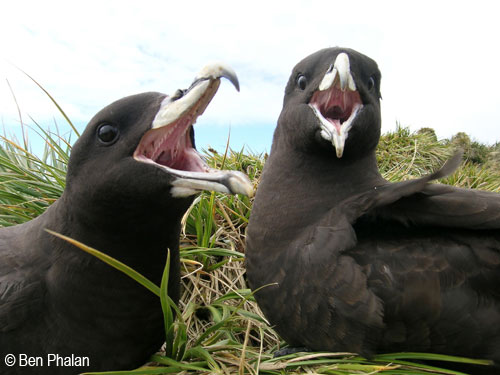Compared to albatrosses and giant petrels, the global populations of burrowing petrels are poorly known. For many of them, only order of magnitude estimates can be given.
However, recent surveys are moving towards attaining a global population figure for at least one ACAP-listed species, the White-chinned Petrel Procellaria aequinoctialis.
Two papers published in 2009 give estimates based on transect surveys for two of the major breeding localities: the Kerguelen Archipelago in the southern Indian Ocean and South Georgia (Islas Georgias del Sur) in the south-western Atlantic. A 2008 paper gives a total of 23 600 breeding pairs for the Crozet Islands. Put together, these three island groups support an estimated 1.15 million pairs of White-chinned Petrels, with the bulk (c. 0.9 million pairs) occurring in the South Atlantic.

In addition to these three completed surveys, counts of occupied burrows were made at Marion Island during the 2008/09 breeding season by researchers at the Percy FitzPatrick Institute, University of Cape Town. Along with a survey of the distribution and densities of burrows on nearby Prince Edward Island made in December 2008, an estimate can then be made for the island group. However, this still leaves breeding localities on three New Zealand southern island groups (Antipodes, Auckland, Campbell) without published population surveys, and so no global estimate is as yet possible.
The White-chinned Petrel remains at serious risk to being killed on longlines, so estimates of its global population size (and regional trends) are important statistics to obtain.
References:
Barbraud, C., Delord, K., Marteau, C. & Weimerskirch, H. 2009. Estimates of population size of White-chinned Petrels and Grey Petrels at Kerguelen Islands and sensitivity to fisheries. Animal Conservation 12: 258-265. http://www3.interscience.wiley.com/journal/122268484/abstract
Barbraud, C., Marteau, C., Ridoux, V., Delord, K. & Weimerskirch, H. 2008. Demographic response of a population if White-chinned Petrels Procellaria aequinoctialis to climate and longline fishery bycatch. Journal of Applied Ecology 45: 1460-1467. http://www3.interscience.wiley.com/journal/121371929/abstract
Martin, A.R., Poncet, S., Barbraud, C. Foster, E., Fretwell, P & Rothery, P. 2009. The White-chinned Petrel (Procellaria aequinoctialis) on South Georgia: population size, distribution and global significance. Polar Biology 32: 655-661. http://www.springerlink.com/content/e416r1p26423752v/?p=3c6d1962b5ab4543b2746dcef0429bbf&pi=13
Click here for the ACAP Species Assessment for the White-chinned Petrel.
John Cooper, ACAP Information Officer, 31 December 2009

 Français
Français  English
English  Español
Español